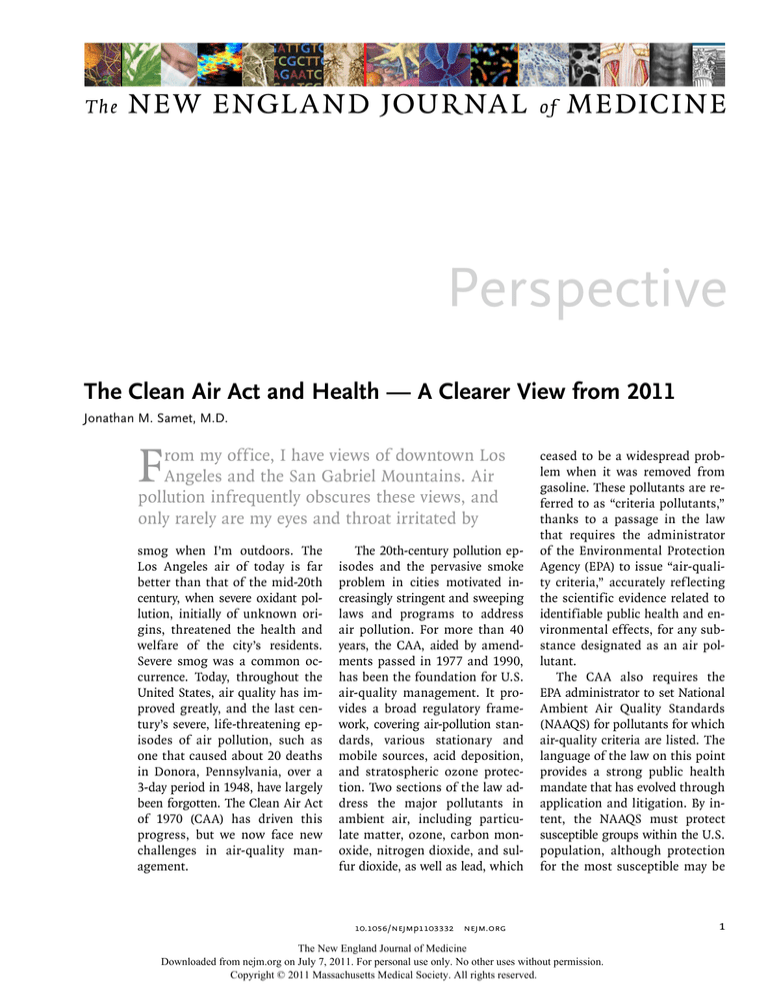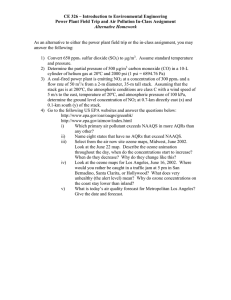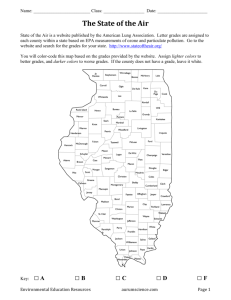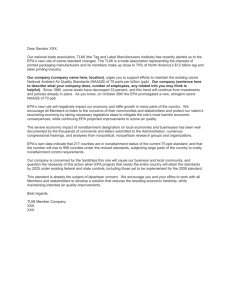
The
NEW ENGLA ND JOURNAL
of
MEDICINE
Perspective
The Clean Air Act and Health — A Clearer View from 2011
Jonathan M. Samet, M.D.
F
rom my office, I have views of downtown Los
Angeles and the San Gabriel Mountains. Air
pollution infrequently obscures these views, and
only rarely are my eyes and throat irritated by
smog when I’m outdoors. The
Los Angeles air of today is far
better than that of the mid-20th
century, when severe oxidant pollution, initially of unknown origins, threatened the health and
welfare of the city’s residents.
Severe smog was a common occurrence. Today, throughout the
United States, air quality has improved greatly, and the last century’s severe, life-threatening episodes of air pollution, such as
one that caused about 20 deaths
in Donora, Pennsylvania, over a
3-day period in 1948, have largely
been forgotten. The Clean Air Act
of 1970 (CAA) has driven this
progress, but we now face new
challenges in air-quality management.
The 20th-century pollution episodes and the pervasive smoke
problem in cities motivated increasingly stringent and sweeping
laws and programs to address
air pollution. For more than 40
years, the CAA, aided by amendments passed in 1977 and 1990,
has been the foundation for U.S.
air-quality management. It provides a broad regulatory framework, covering air-pollution standards, various stationary and
mobile sources, acid deposition,
and stratospheric ozone protection. Two sections of the law address the major pollutants in
ambient air, including particulate matter, ozone, carbon monoxide, nitrogen dioxide, and sulfur dioxide, as well as lead, which
ceased to be a widespread problem when it was removed from
gasoline. These pollutants are referred to as “criteria pollutants,”
thanks to a passage in the law
that requires the administrator
of the Environmental Protection
Agency (EPA) to issue “air-quality criteria,” accurately reflecting
the scientific evidence related to
identifiable public health and environmental effects, for any substance designated as an air pollutant.
The CAA also requires the
EPA administrator to set National
Ambient Air Quality Standards
(NAAQS) for pollutants for which
air-quality criteria are listed. The
language of the law on this point
provides a strong public health
mandate that has evolved through
application and litigation. By intent, the NAAQS must protect
susceptible groups within the U.S.
population, although protection
for the most susceptible may be
10.1056/nejmp1103332 nejm.org
The New England Journal of Medicine
Downloaded from nejm.org on July 7, 2011. For personal use only. No other uses without permission.
Copyright © 2011 Massachusetts Medical Society. All rights reserved.
1
PERSPE C T I V E
The Clean Air Act and Health — A Clearer View
400
200
40
Lead
20
NAAQS (%)
Ozone
Most recent
0
national standard
Annual PM2.5
24-hr PM2.5
−20
−40
PM10
−60
NO2
−80
CO
08
20
06
20
05
20
04
20
03
20
02
20
01
20
00
20
99
20
98
19
97
19
96
19
95
19
94
19
93
19
92
19
91
19
19
19
90
−100
07
SO2
National Levels of the Six Criteria Pollutants, as Percentages of the Levels Set
in the Most Recent National Ambient Air Quality Standards (NAAQS), 1990–2008.
PM2.5 denotes particulate matter with particles less than or equal to 2.5 μm in aerodynamic diameter, PM10 particulate matter with particles less than or equal to 10 μm in
aerodynamic diameter, CO carbon monoxide, NO2 nitrogen dioxide, and SO2 sulfur
dioxide. National levels are averages of levels provided by all monitors with complete
data for the period. Air-quality data for PM2.5 began to be collected in 1999. Data are
from the U.S. Environmental Protection Agency.
unattainable. The achievement of
what the CAA calls an “adequate
margin of safety” does not imply that risk-free levels have been
set, but that an acceptable level
of risk has been reached, given
uncertainties in the evidence. The
costs of implementation and
compliance are not to be considered in setting the NAAQS, although the law does call for
costs to be considered in the setting of individual emission standards (e.g., for vehicles and electric utilities) that are intended
to help meet the NAAQS. Under
the CAA, the Clean Air Scientific Advisory Committee (CASAC,
which I currently chair) provides
peer review for the EPA’s reports
and analyses that support NAAQS
revisions.
Over the 40 years since NAAQS
were first promulgated, they have
2
led to progressive reductions in
levels of criteria pollutants (see
graph). Economic analyses indicate that these reductions have
been highly cost-effective.1 However, as the EPA administrator
now considers revisions to the
NAAQS for particulate matter and
ozone, the CAA’s tenets are being questioned. The questions are
motivated by the possibility that
even lower concentrations for the
NAAQS will be proposed, leading to the designation of large
regions of the country as out of
compliance with the law; such a
result would carry implications
for many municipalities and states
and multiple U.S. industries. The
evidence supporting lowering of
maximum levels comes largely
from epidemiologic studies showing that current levels of particulate matter and ozone are ad-
versely affecting public health.
Discussion of the NAAQS and the
CAA has been further complicated by a U.S. Supreme Court finding that the EPA has authority
to regulate greenhouse gas emissions.
Over the remainder of 2011,
the EPA’s administrator, Lisa Jackson, will make key decisions with
regard to lowering the NAAQS
for particulate matter and ozone.
For ozone, she has reopened the
2007 decision of then-administrator Stephen Johnson to set the
standard at 0.075 ppm as the
8-hour average, which was made
on the basis of the scientific evidence available at the time and
the CASAC’s recommendation that
the limit be in the range of 0.060
to 0.070 ppm. Subsequently, the
CASAC has reaffirmed that recommendation and answered additional questions about the scientific foundation for the ozone
NAAQS. There is great interest
in the administrator’s final decision; in its teleconferences discussing the EPA’s questions on
ozone, the CASAC received input
from 57 public commenters. Some
raised concern that the evidence
was still too uncertain to warrant lowering the NAAQS and
that any mandated reduction
would be costly and lead to the
elimination of jobs, whereas others claimed that such a reduction was needed to meet the CAA’s
requirement for protecting public health. For particulate matter, a decision will be forthcoming by year’s end with regard to
recommended reductions in the
24-hour and annual NAAQS. If
the administrator follows the
CASAC’s recommendations, the
NAAQS will be set at lower levels for both particulate matter
and ozone.
As the NAAQS have been re-
10.1056/nejmp1103332 nejm.org
The New England Journal of Medicine
Downloaded from nejm.org on July 7, 2011. For personal use only. No other uses without permission.
Copyright © 2011 Massachusetts Medical Society. All rights reserved.
PERSPECTIVE
set at lower and lower concentrations, the gaps between acceptable concentrations and irreducible
background levels have narrowed,
raising the question of how much
lower the limits can be pushed.
For ozone and particulate-matter
pollution, because no thresholds
have been identified below which
there is no risk at all, the EPA is
using scenarios of risk and exposure to gauge the effects of
setting the standards at various
concentrations and giving consideration to the burden of avoidable disease. In promulgating the
NAAQS for these pollutants, the
administrator must weigh the public health burden against the uncertainty of the scientific evidence
related to lower concentrations,
keeping in mind the CAA’s requirement for an adequate margin of safety. It is challenging for
researchers to reduce this uncertainty, given the narrowing and
low range of concentrations at
issue and the difficulty of disentangling the effect of one pollutant from those of others.
As an alternative to regulating pollutants one at a time —
the approach outlined in the CAA
Amendments of 1990 — consideration is being given to multipollutant strategies that would
enable the greatest possible reduction in the public health effects of the mixture of inhaled
The Clean Air Act and Health — A Clearer View
pollutants.2 Exposure to trafficrelated pollution generally, for
example, has adverse health effects but is not specifically addressed in the CAA.3 Some multipollutant strategies have already
been introduced. The CASAC has
just reviewed a multi-pollutant
approach for managing the combined effects of oxides of nitrogen and oxides of sulfur as they
are deposited in sensitive aquatic ecosystems.4 More integrated
strategies for air-quality management might also improve control of greenhouse gas emissions, which come from the same
sources as the criteria pollutants. New research approaches
would be needed to support such
integrated strategies.5 Ongoing
research may lead to more refined indicators for particulatematter pollution, to replace the
current mass-based standard,
which includes a mixture of particles from many sources.
Further interpretation or
amendment of the CAA may
eventually be needed to advance
multi-pollutant air-quality management. Revised interpretation
can be controversial and subject
to legal challenge; amendments
have been passed infrequently
and cautiously in the past. But the
individual-pollutant approach no
longer accords as well with our
scientific understanding of air
pollution and its potential hazards for human and environmental health. More integrative
strategies might well address
air-quality problems extending
from local to global levels. Any future Congressional action on the
CAA should be consistent with
the spirit of previous amendments, which recognized that
U.S. standards for air quality
should be grounded in the best
available scientific evidence.
Disclosure forms provided by the author
are available with the full text of this article at NEJM.org.
From the Department of Preventive Medicine, Keck School of Medicine and USC Institute for Global Health, University of
Southern California, Los Angeles.
This article (10.1056/NEJMp1103332) was
published on July 6, 2011, at NEJM.org.
1. Krupnick A, Morgenstern R. The future of
benefit-cost analyses of the Clean Air Act.
Annu Rev Public Health 2002;23:427-48.
2. National Research Council. Air quality
management in the United States. Washington, DC: National Academies Press, 2004.
3. Health Effects Institute. Traffic-related air
pollution: a critical review of the literature on
emissions, exposure, and health effects.
Special report 17. Boston: Health Effects Institute, 2010.
4. Policy assessment for the review of the
secondary national ambient air quality standards for oxides of nitrogen and oxides of
sulfur. Research Triangle Park, NC: Environmental Protection Agency, 2011.
5. Mauderly JL, Burnett RT, Castillejos M, et
al. Is the air pollution health research community prepared to support a multipollutant
air quality management framework? Inhal
Toxicol 2010;22:Suppl 1:1-19.
Copyright © 2011 Massachusetts Medical Society.
10.1056/nejmp1103332 nejm.org
The New England Journal of Medicine
Downloaded from nejm.org on July 7, 2011. For personal use only. No other uses without permission.
Copyright © 2011 Massachusetts Medical Society. All rights reserved.
3







